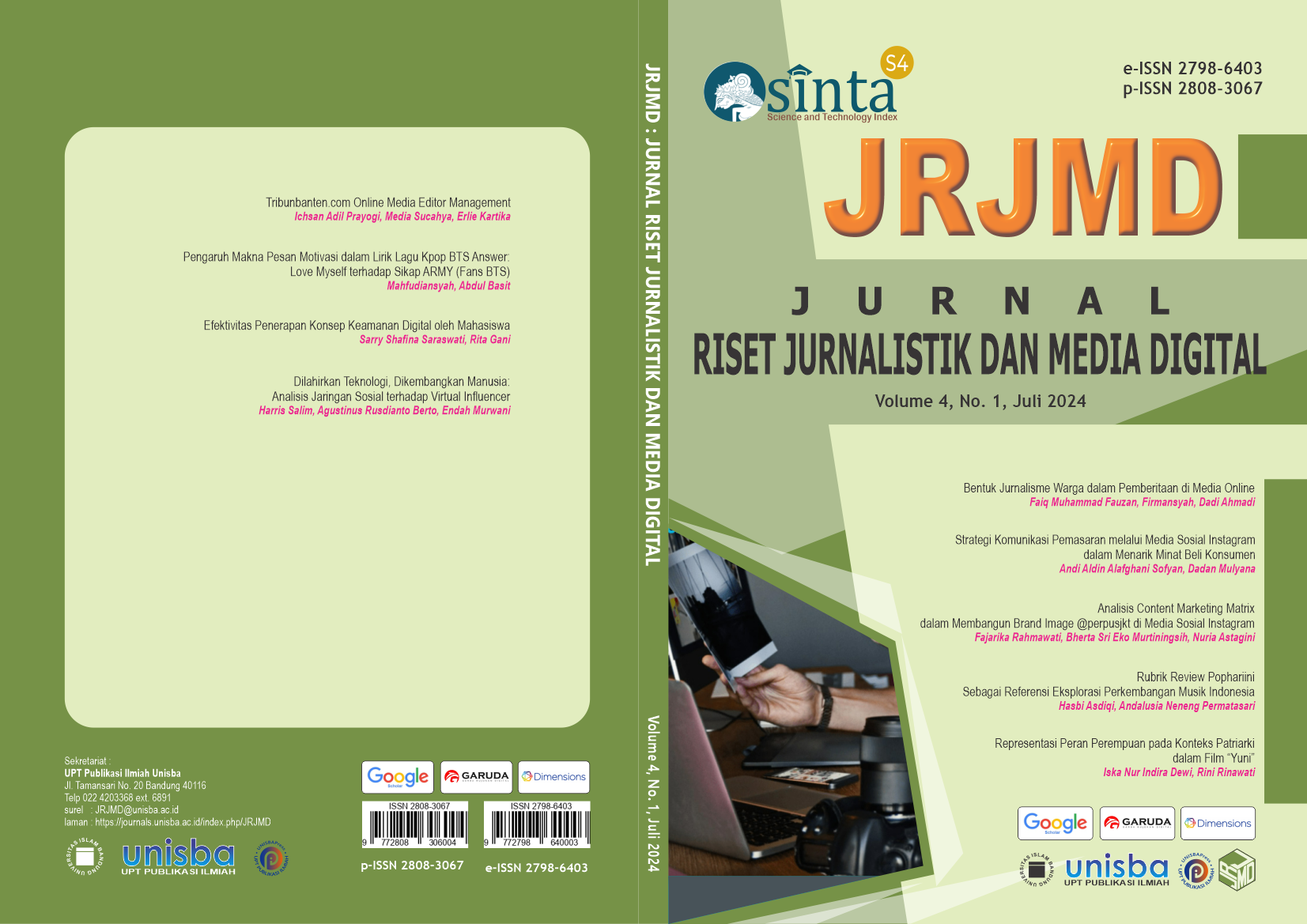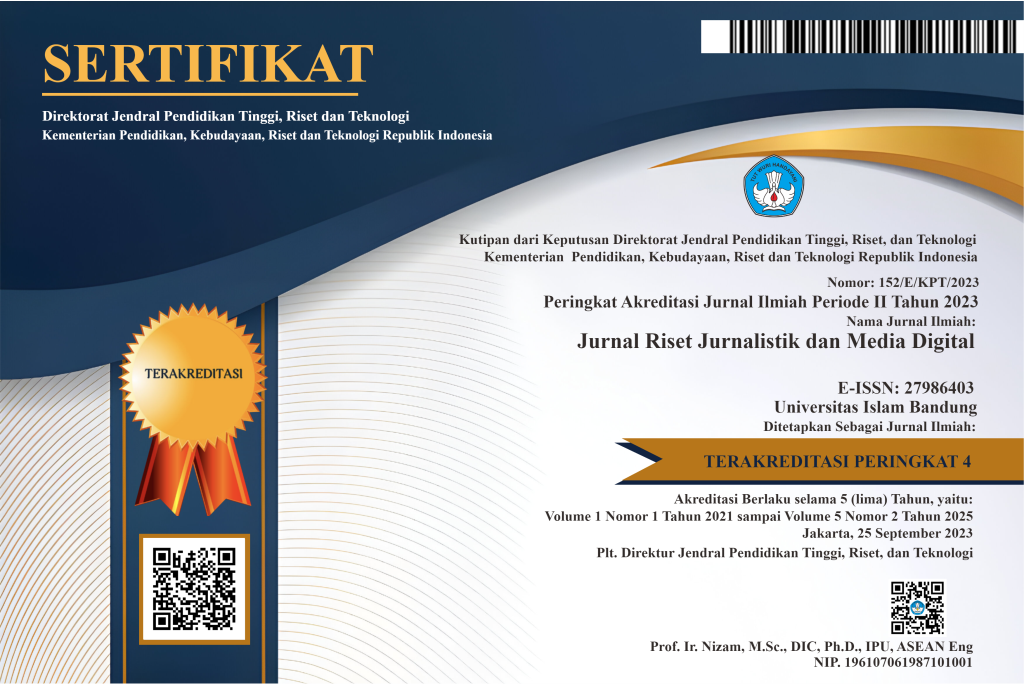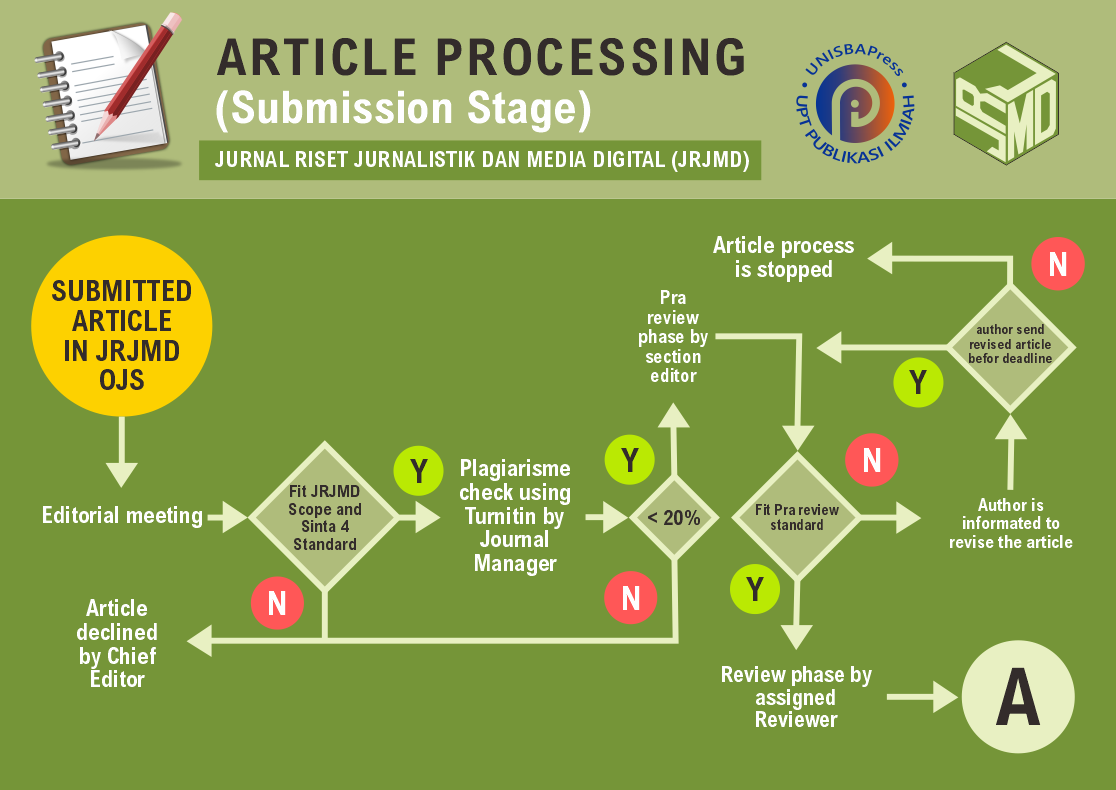Dilahirkan Teknologi, Dikembangkan Manusia: Analisis Jaringan Sosial terhadap Virtual Influencer
DOI:
https://doi.org/10.29313/jrjmd.v4i1.3942Keywords:
Matahuman, Adopsi Inovasi, SentimenAbstract
Abstrak. Metahuman merupakan manusia digital yang dilahirkan oleh kemajuan teknologi. Banyak akun-akun sosial media yang memperkenalkan diri mereka sebagai metahuman di Indonesia sendiri metahuman sudah hadir sejak tahun 2018 yang memiliki tampilan menyerupai manusia sehingga metahuman memiliki kemampuan untuk menyampaikan pesan kepada publik dan digunakan untuk kegiatan periklanan digital. Melihat dari salah satu video YouTube dari akun Arbie Seo penelitian ini ditujukan untuk mengetahui tanggapan pengguna YouTube Indonesia tentang fenomena metahuman khususnya Arbie Seo melalui analisis sentimen dan analisis jaringan kelompok menggunakan metode Social Network Analysis (SNA) network. Hasil penelitian menunjukan mayoritas komentar dengan sentimen netral yang menunjukan adanya kebingungan tentang konsep metahuman. Pada jaringan kelompok ditemukan adanya lima klaster yang didominasi oleh komentar dengan sentimen netral. Komentar dengan sentimen negatif memiliki jumlah yang lebih banyak daripada sentimen positif akan tetapi komentar dengan sentimen negatif tidak menyebabkan adanya diskusi pada kolom komentar. Komentar dengan sentimen netral ini jika tidak ditanggapi dengan baik dapat berpotensi memberikan persepsi negatif terhadap metahuman dikarenakan komentar sentimen negatif yang terjadi akibat adanya mispersepsi metahuman dan robot. Komentar dengan sentimen negatif yang meyebutkan robot menunjukan ketakutan dan mengaitkan dengan kiamat. Pengembang metahuman harus dapat memberikan informasi terhadap konsep metahuman agar metahuman dapat dipersepsikan secara positif dan manusia dapat mengadopsi metahuman sebagai inovasi yang dapat membantu kehidupan manusia.
Abstract. Metahuman is a digital human being born by technological advances. Many of the social media accounts that introduce themselves as metahuman in Indonesia themselves have been present since 2018 that have a human-like appearance so that metahumans have the ability to convey messages to the public and are used for digital advertising activities. Looking at one of the YouTube videos from Arbie Seo's account, this research aims to find out the responses of YouTube users Indonesia about metahuman phenomena in particular Arbie SEO through sentimental analysis and group network analysis using the Social Network Analysis method. (SNA). The results showed a majority of comments with neutral sentiment that showed confusion about the concept of metahumanism. On the network of groups found five clusters dominated by comments with neutral sentiment. Comments with negative feelings have more than positive feelings, but comments with negative sentiments do not lead to discussion in the comment column. Comments with neutral feelings if not responded well can potentially give a negative perception of metahuman due to negative sentimental comments that occur as a result of misperceptions of meta-humans and robots.
References
Aji, D. S., & Arianto, I. D. (2023). Analisis Jaringan Komunikasi Holywings pada Promosi Muhammad-Maria di Twitter. Jurnal Pustaka Komunikasi, 6(1), 56–71.
Böhndel, M., Jastorff, M., & Rudeloff, C. (2023). AI-Driven Influencer Marketing: Comparing the Effects of Virtual and Human Influencers on Consumer Perceptions. SSRN Electronic Journal. https://doi.org/10.2139/ssrn.4404372
Dewi, N. S. (2023, May 10). Top Virtual influencer di dunia dan Indonesia. DigiNation. https://www.digination.id/read/019069/top-virtual-influencer-di-dunia-dan-indonesia
Hadiwinata, L. N., Murtiningsih, B. S. E., & Berto, A. R. (2023). ANALISIS TEKS DAN JARINGAN PROMOSI MEDIA SOSIAL YOUTUBE MOBIL LISTRIK IONIQ 5 MENGGUNAKAN METODE SNA. Perspektif Komunikasi: Jurnal Ilmu Komunikasi Politik Dan Komunikasi Bisnis, 7(1), 1. https://doi.org/10.24853/pk.7.1.1-18
Halim, E., Adiba, C. N. A., Kurniawan, Y., & Saputra, L. S. (2022). Comparative Analysis of the Effect of Live Streaming Shopping on E-commerce and S-commerce on Impulsive Buying Behavior in Indonesia. Proceedings of the 3rd Asia Pacific International Conference on Industrial Engineering and Operations Management.
Julian, H. L. C., Chung, T., & Wang, Y. (2023). Adoption of Metaverse in South East Asia (pp. 196–234). https://doi.org/10.4018/978-1-6684-5732-0.ch012
Lee, M., & Yoon, H. J. (2020). When brand activism advertising campaign goes viral: An analysis of always# LikeAGirl video networks on YouTube. International Journal of Advanced Culture Technology, 8(2), 146–158.
Murjani, M. (2022). Pergeseran Nilai-Nilai Religius Dan Sosial Di Kalangan Remaja Para Era Digitalisasi. EDUCATIONAL JOURNAL: General and Specific Research, 2(1), 1–18.
Nalbant, K. G., & Uyanik, Ş. (2022). A look at the new humanity: metaverse and metahuman. International Journal of Computers, 7.
ROSSI, C., & Rivetti, F. (2023). Virtual Influencer Marketing: Is It Effective in Engaging Younger Generations? European Conference on Social Media, 10(1), 231–240. https://doi.org/10.34190/ecsm.10.1.1061
Susanto, B., Lina, H., & Chrismanto, A. R. (2012). Penerapan Social Network Analysis dalam Penentuan Centrality Studi Kasus Social Network Twitter. Jurnal Informatika, 8(1). https://doi.org/10.21460/inf.2012.81.111
Vrontis, D., Makrides, A., Christofi, M., & Thrassou, A. (2021). Social media influencer marketing: A systematic review, integrative framework and future research agenda. International Journal of Consumer Studies, 45(4), 617–644. https://doi.org/10.1111/ijcs.12647
Wan, A., & Jiang, M. (Montina). (2023). Can Virtual Influencers Replace Human Influencers in Live-Streaming E-Commerce? An Exploratory Study from Practitioners’ and Consumers’ Perspectives. Journal of Current Issues & Research in Advertising, 44(3), 332–372. https://doi.org/10.1080/10641734.2023.2224416














